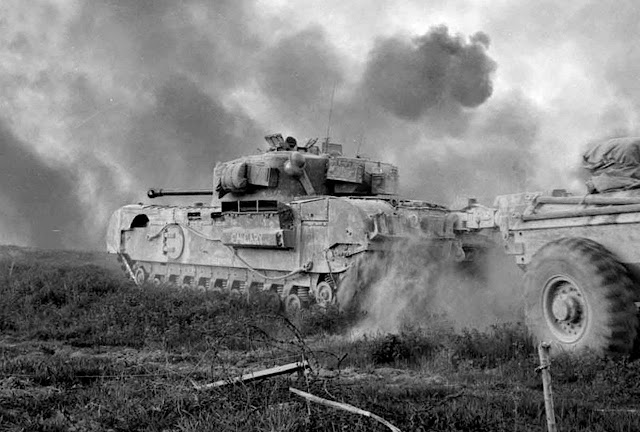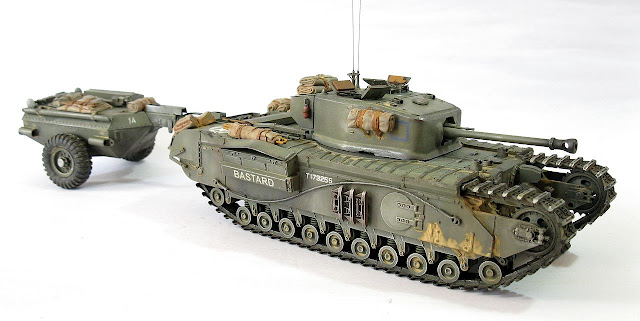Tankers!!!
Flamethrowers are a horrible weapon, without a doubt ... And in WWII they had their biggest moment... Let us know what many consider the best vehicle developed for this terrible function. We are talking about the British Churchill Mk. VII Crocodile - flamethrower tank.
 |
| Churchill Mk.VII Crocodile - 141st RAC - Höngen - Germany, 1945 Notice the Churchill Mk VII wearing full winter cammo... |
History:
The Churchill Crocodile was a British flamethrower tank of late WWII. It was a variant of the Tank, Infantry, Mk VI (A22) Churchill Mark VII, although the Churchill Mark IV was initially chosen to be the base vehicle.
 |
| Churchill Mk. VII Crocodile in trials - August, 1944. |
The Crocodile was introduced as one of the specialised armoured vehicles developed under Major-General Percy Hobart, informally known as "Hobart's Funnies". It was produced from October 1943, in time for the Normandy invasion.
Design and development:
From early in the war, there had been experiments with mounting flamethrowers on British vehicles; leading to vehicles such as the Cockatrice, Basilisk and the Wasp (the latter being a flamethrower on a Universal Carrier). The Churchill Oke, a flamethrower carrying Churchill Mark II developed by a Royal Tank Regiment officer, was tested operationally on the Dieppe Raid.
 |
| Churchill Oke. Notice the armoured fuel tank (for flamethrower) in the rear of the operational version. |
Parallel development work was carried out by the Petroleum Warfare Department, AEC and the Ministry of Supply (MoS) on Valentine tanks. The Department of Tank Design preferred the Churchill, which was the Infantry tank successor to the Valentine, as a basis for further work.
General Percy Hobart saw the Crocodile demonstrated in 1943 and pressured the MoS to produce a development plan and the Chief of the General Staff added the flamethrowers to the 79th Division plan.
Final design:
 |
| Churchill Crocodile flame-thrower on trials Eastwell Park, Ashford, Kent, 26 Apr 1944. |
The flamethrower equipment was produced as a kit that REME workshops could fit in the field, converting any available Churchill Mk VII gun tank. The conversion kit consisted of the trailer, an armoured pipe fitted along the underside of the tank, and the projector, which replaced the hull mounted Besa machine gun.
The Crocodile was therefore still able to function as a gun tank with its turret mounted Ordnance QF 75 mm gun.
 |
| Flamethrower projector in Churchill Crocodile front hull... |
Of the 800 kits produced, 250 were held in reserve for possible operations against the Japanese. The remainder was sufficient for producing three regiments of tanks as well as training and replacements for battlefield casualties.
The Crocodile's six and a half ton, armoured trailer carried 1,800 liters of fuel as well as five cylinders containing compressed gas propellant.
 |
| Churchill Crocodile flame-thrower tank under trials by 79th Armoured Division, 13 Feb 1944. |
 |
| Close-up of the armoured fuel trailer |
 |
| The Link: three way armoured coupling between tank and trailler |
For transport over long distances, Crocodile units were issued with AEC Matador lorries to tow the trailers. The tanks themselves would be moved on tank transporters.
The thrower had a range of up to 110 m, although some sources quote almost 140 m. To ignite the flame, the projector used a fine spray of petrol from the Crocodile's main fuel tank, this was ignited by a spark plug, and in turn ignited the main fuel jet. The operator could spray long or short bursts of flaming fuel onto the target. The operator could also spray the target with unignited fuel, then set it on fire with a short, lit burst. See below the Churchill Crocodile tank GRACE in operational training:
Refuelling took at least 90 minutes and pressurization around 15 minutes; the pressure required had to be primed on the trailer by the crew as close to use as feasible, because pressure could not be maintained for very long.
The fuel was projected at a rate of 18 liters per second. The fuel burned on water and could be used to set fire to woods and houses.
Refuelling took at least 90 minutes and pressurization around 15 minutes; the pressure required had to be primed on the trailer by the crew as close to use as feasible, because pressure could not be maintained for very long.
 |
| Refueling the trailer with fuel and gas bottles... |
Service:
Used by units of the 79th Armoured Division in concert with the Churchill AVRE, and other Funnies, the Crocodile was an effective assault weapon whose threat could induce enemy troops to retreat or surrender.
The Crocodile was a specialised weapon limited by the short range of its flamethrower. On the other hand, it was used so successfully against bunkers that many surrendered after the first ranging shots. Aspects of the mechanism were considered by the British to be so secret that disabled units, if they could not be recovered, were rapidly destroyed by any means, even air strike, if necessary.
 |
| Churchill Crocodile flamethrower tank of 31st Armoured Brigade, 79th Armoured Division, moves past a church at Oberhausen in the Ruhr, Germany, April 1945 |
British Crocodiles supported the U.S. Army in the Normandy bocage, at the Battle for Brest, and during Operation Clipper, the Anglo-American assault on Geilenkirchen. C Squadron also supported the 53rd Welch Division assault on 's-Hertogenbosch in October 1944.
The units that used the Crocodile in North west Europe, generally as part of 31st Armoured Brigade, were:
 |
| Crocodiles of B Squadron, 141 st Royal Armored Corps, which took part in the American attack on Fort Montbarey, Brest, France in Sep 1944. |
 |
| Same Crocodiles of B Squadron, 141 st Royal Armored Corps seen above |
 |
| Churchill Crocodiles were assigned to support the US infantry on the assault on Fort Montbarey Brest, France in Sep 1944. |
 |
| Churchill Crocodile smashing a german staff car in his attack to Fort Montbarey, Brest, France - Sep 1944. |
- 1st Fife and Forfar Yeomanry
- 141st Regiment Royal Armoured Corps (The Buffs, Royal East Kent Regiment) - 13th Troop, C Squadron saw action on the first day of the Normandy invasion.
- 7th Royal Tank Regiment
 |
| Churchill Mk.VII Crocodiles and Churchill Mk.V CS tanks of the 1st Fife and Forfar Yeomanry. Germany, Nov 1944. |
In Italy, the 25th Armoured Assault Brigade (51st (Leeds Rifles) Royal Tank Regiment)) operated Crocodiles.
 |
| Churchill Crocodile "Calgary" of 51st Royal Tank Regiment, C Squadron, attached to the 2nd New Zealand Division, sprays flame across the Senio River prior to the Allied crossing on April 9, 1945. |
 |
| Churchill flame throwing tanks Crocodiles with fascines, waiting in Granarolo dellEmilia - Italy, April 1945. |
 |
| Churchill Crocodiles - C Squadron, 7th Royal Tank Regiment - 29th Brigade. Korea, 1950 |
Specs:
| Churchill Mk.VII Crocodile | |
|---|---|
| Type | Flamethrower tank |
| Place of origin Wars | United Kingdom WWII Korean War |
| Service history | |
| In service | 1943- 1950 British Empire |
| Used by |
|
| Production history | |
| Designer | Vauxhall Motors (A22) |
| Manufacturer | Vauxhall Motors |
| Produced | 1943 |
| No. built | 800 conversion kits |
| Specifications | |
| Mass |
|
| Length | 7.44 m |
| Width | 3.25 m |
| Height | 2.49 m |
| Crew | 5 (commander, gunner, loader/radio operator, driver, co-driver/hull gunner) |
| Armour |
|
Main armament | |
Secondary armament |
|
| Engine | Bedford 12-cylinder, 4 stroke, water-cooled, horizontally opposed, L-head petrol engine 350 hp (261 kW) at 2,200 rpm |
| Power/weight | 9.1 hp (6.7 kW) / tonne |
| Transmission | Merritt-Brown 4-speed constant-mesh epicyclic gearbox |
| Suspension | Coiled spring |
Operational range | 90 km |
| Speed | 24 km/h |
Steering system | Triple differential steering in gearbox |
Kit:
About the kit, this is the only option in the market, for a long time: I built this girl many years ago and she was with the wrong markings and weird colors but very well built. I decided to remove the paint and old markings with caustic soda (see the article on Churchill Mk.VII) and make a nice up-grade on the model.
Of course this kit does not have the same level of detail as the most modern AFC Club Churchill family kits, but this Tamiya one (from 1977... amazing!!) still an example of very well-injected and extremely easy to assemble kit, keeping the Tamiya tradition of perfect fittings and swift building. The contents of the kit box:
 |
| Churchill Crocodile - Tamiya kit (#35100) |
 |
| Vinyl tracks (very good indeed!!) |
 |
| Tank building instructions |
 |
| Fuel trailer instructions |
 |
| Markings and paintings... |
The building steps unfortunately they were not preserved, but I have the overhaulin photos I made this year. First, the markings: Churchill Mk.VII Crocodile BASTARD,from 79th Armoured Division (The Funnies) - 1st Fife & Forfar Yeomanry - B Squadron, in duties in Germany, Rhine, March-1945.
My decals, after researching in this excellent book of Dick Taylor:
Meet BASTARD, Churchill Mk.VII Crocodile from 79th Armoured Division (The Funnies) - 1st Fife & Forfar Yeomanry - B Squadron, in duties in Germany, Rhine, March-1945.
 |
| Value Gear details in the rear deck and turret... |
 |
| Value Gear details in the trailer, too... |
 |
| Churchill Mk.VII Crocodile BASTARD,from 79th Armoured Division (The Funnies) 1st Fife & Forfar Yeomanry - B Squadron, in duties in Germany, Rhine, March-1945, with Kojak and Rover, the dog. |
 |
| Churchill Mk.VII Crocodile BASTARD,from 79th Armoured Division (The Funnies) 1st Fife & Forfar Yeomanry - B Squadron, in duties in Germany, Rhine, March-1945. |
See you, soon!!!







































0 Yorumlar